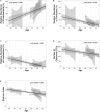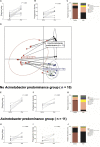Changes in Gastric Corpus Microbiota With Age and After Helicobacter pylori Eradication: A Long-Term Follow-Up Study
- PMID: 33633697
- PMCID: PMC7900007
- DOI: 10.3389/fmicb.2020.621879
Changes in Gastric Corpus Microbiota With Age and After Helicobacter pylori Eradication: A Long-Term Follow-Up Study
Abstract
Helicobacter pylori infection changes gastric microbiota profiles. However, it is not clear whether H. pylori eradication can restore the healthy gastric microbiota. Moreover, there has been no study regarding the changes in gastric microbiota with aging. The objective of this study was to investigate the changes in gastric corpus microbiota with age and following H. pylori eradication. Changes in corpus mucosa-associated microbiota were evaluated in 43 individuals with endoscopic follow-up > 1 year, including 8 H. pylori-uninfected and 15 H. pylori-infected subjects with no atrophy/metaplasia by histology and pepsinogen I/II ratio > 4.0; 17 H. pylori-infected subjects with atrophy/metaplasia and pepsinogen I/II ratio < 2.5; and 3 subjects with atrophy/metaplasia, no evidence of active H. pylori infection, negative for anti-H. pylori immunoglobulin G (IgG) antibody testing, and no previous history of H. pylori eradication. Successful H. pylori eradication was achieved in 21 patients. The gastric microbiota was characterized using an Illumina MiSeq platform targeting 16S ribosomal DNA (rDNA). The mean follow-up duration was 57.4 months (range, 12-145 months), and median follow-up visit was 1 (range, 1-3). Relative abundance of Lactobacillales and Streptococcus was increased with atrophy/metaplasia. In H. pylori-uninfected subjects (n = 8), an increase in Proteobacteria (Enhydrobacter, Comamonadaceae, Sphingobium); a decrease in Firmicutes (Streptococcus, Veillonella), Fusobacteria (Fusobacterium), Nocardioidaceae, Rothia, and Prevotella; and a decrease in microbial diversity were observed during the follow-up (p trend < 0.05). In 10 of 21 subjects (47.6%), H. pylori eradication induced restoration of microbial diversity; however, a predominance of Acinetobacter with a decrease in microbial diversity occurred in 11 subjects (52.3%). The presence of atrophy/metaplasia at baseline and higher neutrophil infiltration in the corpus were associated with the restoration of gastric microbiota after successful eradication, whereas a higher relative abundance of Acinetobacter at baseline was associated with the predominance of Acinetobacter after H. pylori eradication (p < 0.05). To conclude, in H. pylori-uninfected stomach, relative abundance of Proteobacteria increases, relative abundance of Firmicutes and Fusobacteria decreases, and microbial diversity decreases with aging. H. pylori eradication does not always restore gastric microbiota; in some individuals, gastric colonization by Acinetobacter species occurs after anti-Helicobacter treatment.
Keywords: Helicobacter pylori; atrophic gastritis; eradication; gastric microbiota; intestinal metaplasia.
Copyright © 2021 Shin, Kim, Park and Lee.
Conflict of interest statement
The authors declare that the research was conducted in the absence of any commercial or financial relationships that could be construed as a potential conflict of interest.
Figures




Similar articles
-
Effect of Helicobacter pylori on gastrointestinal microbiota: a population-based study in Linqu, a high-risk area of gastric cancer.Gut. 2020 Sep;69(9):1598-1607. doi: 10.1136/gutjnl-2019-319696. Epub 2019 Dec 19. Gut. 2020. PMID: 31857433 Free PMC article.
-
Gastric microbes associated with gastric inflammation, atrophy and intestinal metaplasia 1 year after Helicobacter pylori eradication.Gut. 2020 Sep;69(9):1572-1580. doi: 10.1136/gutjnl-2019-319826. Epub 2020 Jan 23. Gut. 2020. PMID: 31974133 Free PMC article. Clinical Trial.
-
[The assessment of nitric oxide metabolites in gastric juice in Helicobacter pylori infected subjects in compliance with grade of inflammatory lesions in gastric mucosa].Pol Merkur Lekarski. 2008 Feb;24(140):95-100. Pol Merkur Lekarski. 2008. PMID: 18634262 Polish.
-
Effect of Helicobacter Pylori Eradication on Human Gastric Microbiota: A Systematic Review and Meta-Analysis.Front Cell Infect Microbiol. 2022 May 4;12:899248. doi: 10.3389/fcimb.2022.899248. eCollection 2022. Front Cell Infect Microbiol. 2022. PMID: 35601105 Free PMC article.
-
Helicobacter pylori, gastric microbiota and gastric cancer relationship: Unrolling the tangle.World J Gastrointest Oncol. 2022 May 15;14(5):959-972. doi: 10.4251/wjgo.v14.i5.959. World J Gastrointest Oncol. 2022. PMID: 35646287 Free PMC article. Review.
Cited by
-
Microbial Profiles of Patients With Antipsychotic-Related Constipation Treated With Electroacupuncture.Front Med (Lausanne). 2021 Oct 14;8:737713. doi: 10.3389/fmed.2021.737713. eCollection 2021. Front Med (Lausanne). 2021. PMID: 34722577 Free PMC article.
-
The Impact of Immune System Aging on Infectious Diseases.Microorganisms. 2024 Apr 11;12(4):775. doi: 10.3390/microorganisms12040775. Microorganisms. 2024. PMID: 38674719 Free PMC article. Review.
-
Comparative study of gastric microbiota between patients with autoimmune gastritis and those with atrophic gastritis.Sci Rep. 2025 Jul 29;15(1):27658. doi: 10.1038/s41598-025-12211-3. Sci Rep. 2025. PMID: 40731012 Free PMC article.
-
Using Probiotics as Supplementation for Helicobacter pylori Antibiotic Therapy.Int J Mol Sci. 2020 Feb 8;21(3):1136. doi: 10.3390/ijms21031136. Int J Mol Sci. 2020. PMID: 32046317 Free PMC article. Review.
-
Stomach microbiota in gastric cancer development and clinical implications.Gut. 2024 Nov 11;73(12):2062-2073. doi: 10.1136/gutjnl-2024-332815. Gut. 2024. PMID: 38886045 Free PMC article. Review.
References
-
- Choi I. J., Kook M. C., Kim Y. I., Cho S. J., Lee J. Y., Kim C. G., et al. (2018). Helicobacter pylori therapy for the prevention of metachronous gastric cancer. N. Engl. J. Med. 378 1085–1095. - PubMed
LinkOut - more resources
Full Text Sources
Other Literature Sources

